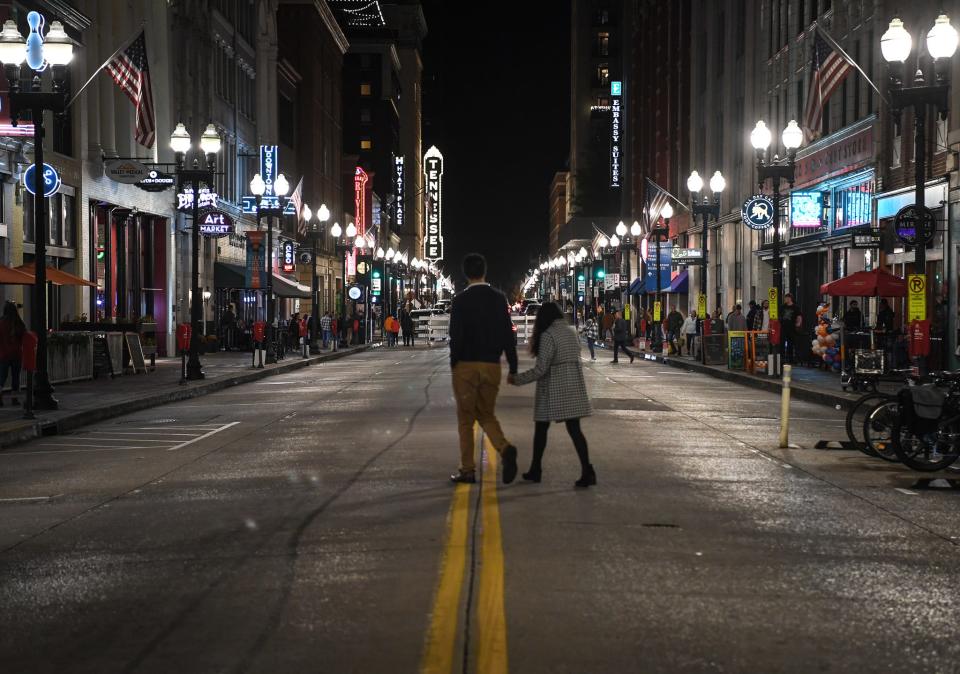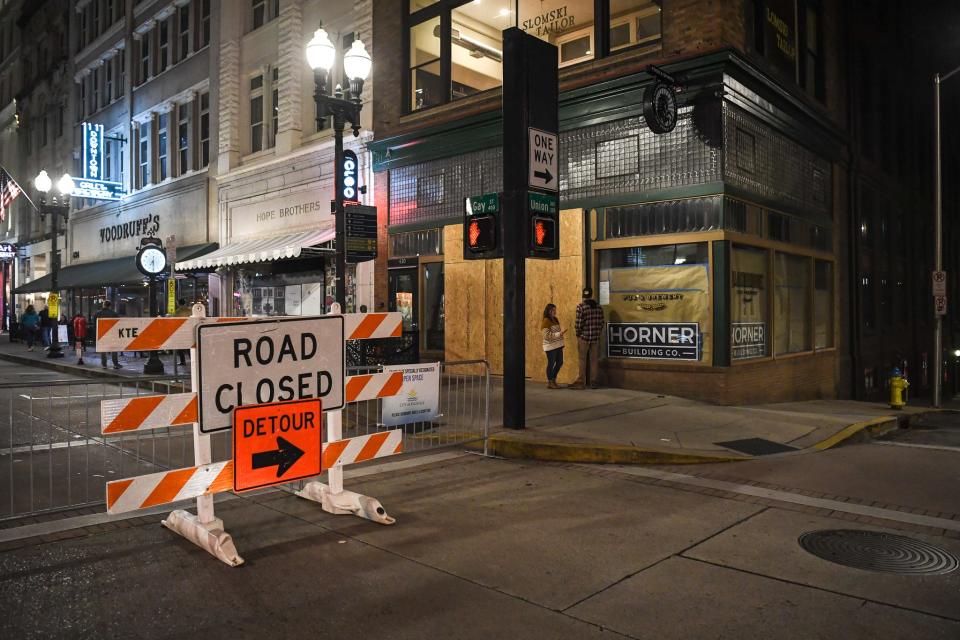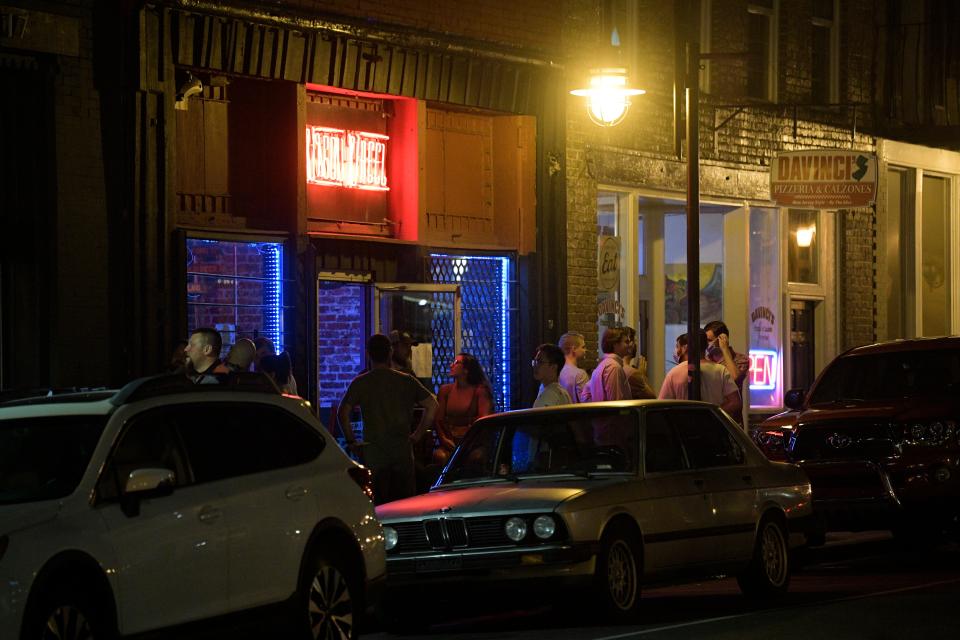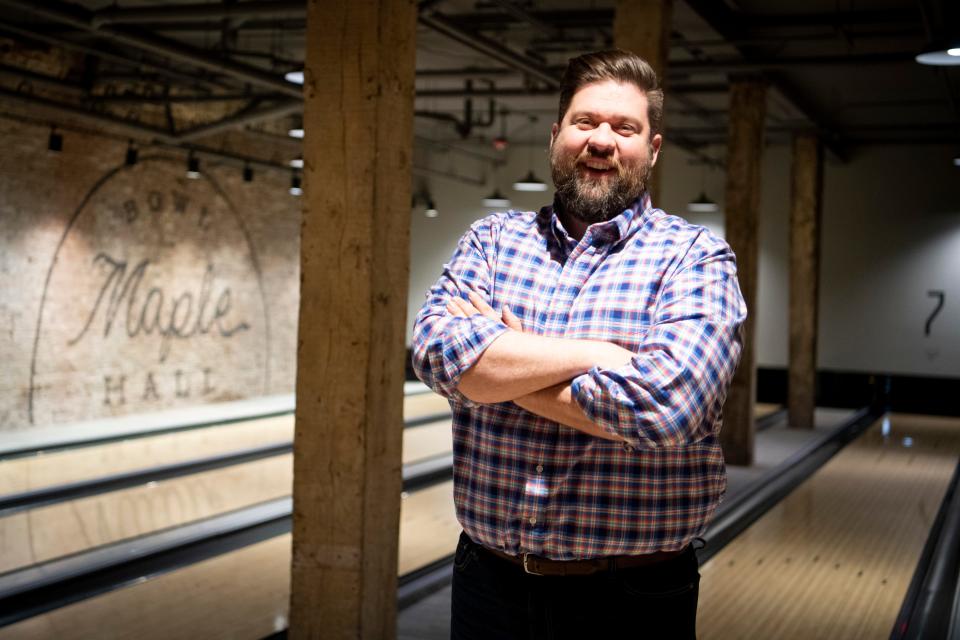Booze? Games? More promotion? What the Gay Street pedestrian experiment needs to succeed
On a damp November night, South Gay Street had more puddles than people taking advantage of its temporary pedestrian-only 400 block between Mast General Store and Cruze Farm. Those who did venture beyond the barricades were met with the type of fun typically experienced in an above-ground pool: We’re in here, now what?
Pool toys help. So, in similar fashion, Suttree’s High Gravity Tavern brought foosball tables into the street the following night, just as it did in 2018 when Gay Street was closed for construction. Cornhole boards were placed in front of Skybox Sports Bar and Grill, and football fans perused the block before stopping in businesses following Tennessee’s loss to Georgia on Nov. 18.
Is that success? It’s hard to tell without a few more weeks under the city’s belt, but experts in pedestrian-only streets say these experiments are most successful when they feature activities for people to enjoy. It could be the difference between creating a waterpark of an experience or a glorified bathtub.
Business owners in the 400 block think Gay Street needs more foot traffic. Despite being in the heart of downtown’s main thoroughfare, their businesses compete every day with the pedestrian draw of Market Square just to the west.
Visit Knoxville counts pedestrian traffic in given areas using Placer.ai, which uses machine learning and data science to generate analytics. The data generally excludes residents and employees within the zone, as well as vehicle traffic.
Between January and October, Market Square welcomed about 794,400 visitors who collectively accounted for 1.3 million visits. The 400-700 blocks of Gay Street had about 538,200 visitors and 933,600 visits during that same time, according to Visit Knoxville’s Placer.ai data.
The difference between visitors and visits? It's similar to an internet user who visits the same website multiple times.
“Most of my clients … come down here for special events and concerts and football and whatever, and they don’t realize how nice Gay Street has become over the last two to three years,” Kenny Chimeno, owner of the daquiri bar Fat Tuesday in the 400 block, told Knox News. “We as business owners can promote our own business all we want. But if people don’t feel like Gay Street or downtown is safe, they’re not going to come.”
Creating “safe spaces” was a selling point in Knoxville Mayor Indya Kincannon’s announcement about the city experiment, which occurs 7 p.m. to 4 a.m. select Fridays and Saturdays during the fall. Knoxville residents and visitors have two more weekends to experience the open street during the pilot program: Dec. 8-9 and Dec. 15-16.
City COO Grant Rosenberg told Knox News by email the 400 block was picked because of its “popular destinations,” as well as its “traffic patterns and parking systems.”
But there are two things Gay Street business owners and urbanites are whispering about even if the city isn’t addressing them directly in this effort: That open streets seems like a natural segue to open container and that redirecting traffic would cut down on excessive car noise.
Let’s start with the former.
Open Gay Street revives talks of open container in Knoxville
Knoxville closed the lid on an unofficial open container proposal in 2021 that would have allowed people to drink beer in public areas of Market Square.
Market Square business owner Scott West, who proposed the change, wasn’t calling for a free-for-all − just a new model to promote business and add vibrancy to the pedestrian plaza, a rare amenity for a city but one that seems to be getting less attention since events began moving to the renovated World’s Fair Park.
Part of the argument against open container dealt with the family friendliness of Market Square, suggesting alcohol cannot be consumed responsibly in the presence of kids, even though many Knoxville breweries keep games on hand for children and are popular hangouts for families.
While it’s tough to argue the 400 block of South Gay Street is any less family friendly than Market Square, the experiment’s hours suggest this amenity is more for the going-out crowd than window shoppers and weekend ice cream eaters.

Retail businesses Mast General Store and Bliss & Tori Mason Shoes close at 9 p.m. Fridays and Saturdays, while Cruze Farm and Kilwins close at 10 p.m. Businesses with bars generally stay open later: Downtown Grill & Brewery until 11 p.m., Suttree’s until midnight, Skybox until 1 a.m. and Maple Hall until 1:30 a.m.
Open container might not be what the city is planning long term, but it's a natural pairing with open streets.
Even without it, people inevitably will assume they can bring drinks from bars to the inviting open street. It didn't take long to notice alcohol out in the open Nov. 17 when Knox News paid a visit to the 400 block − though, nothing more than a couple beers in hands.
It's worth noting city officials likely would face public scrutiny for suggesting open container, but the pressure is lessened if they consider the concept as a solution to a problem that's happening.
If the 400 block becomes a permanent pedestrian zone on weekends, the city could expect drinking to continue. That leaves a few options for city officials:
Nix open streets because of alcohol consumption outside
Simply ignore the drinking
Pump resources into education about where drinking is allowed
Take a punitive approach
Give open container its own pilot program, as the city did with electric scooters and as it’s considering with food delivery robots
Which will they choose? Time will tell.
Some clear advice for Gay Street by city transportation experts
Sticking with the pilot program – which opens the 400 block on some weekend evenings – the National Association of City Transportation Officials has crafted guidelines for effectively creating a pedestrian zone.
Installing a barricade to prevent vehicle traffic is the only “critical” guideline, and the transportation association notes police enforcement is not always desirable – with an exception of nighttime closures like this one.

But because the experiment is a road closure and not a special event, Knoxville Police Department’s presence is “minimal,” police spokesperson Scott Erland told Knox News via email.
“Central District officers will always be nearby and prepared to respond in the event of a public safety issue or emergency,” he said. “The first weekend (Nov. 10-11) was by most measures uneventful from a safety standpoint.”
The second weekend also was routine, he said.
The other recommendations from the National Association of City Transportation Officials include:
Adding signs to identify regularly scheduled closures
Creating activities throughout the day, including performances and food stalls
Adding street furniture to bring a relaxing social element to the street
Allowing loading and unloading for local businesses outside closure hours
Considering branding to attract the targeted audience
Adding extra lighting, street monitoring and police enforcement at nighttime
Allowing bicyclists in certain cases
The city wants feedback during the pilot period before considering other locations, Rosenberg said. Whether open container is in the cards, the 100 block of South Central Street in the Old City seems like a candidate.
The block has far fewer visitors than Gay Street: roughly 113,000 between January and October, according to Visit Knoxville’s Placer.ai data, totaling roughly 196,100 visits. Part of the street was temporarily closed earlier this year, albeit by pranksters and not police.

The pranksters who moved “road closed” signs to the block is a microcosm of the block’s partying nature – the place where college students bounce from club to club to drunken pizza restaurant, sometimes spilling out onto the streets.
Using the city’s own reasoning for closing the 400 block, a street closure on South Central Street could promote pedestrian traffic and safety.
Downtown Knoxville business owners excited for Gay Street experiment
In Mayor Kincannon’s announcement about closing the 400 block to vehicles, she pointed to cities like Nashville and New Orleans as examples of places with open streets.
She also mentioned Paris, so it’s only fair we look at a 2018 European study on the economic benefits of walking and cycling.
Transport for London, a local government body, found people not traveling by car spend up to 40% more per month than motorists while shopping on the “high street,” a British name for a town’s primary street.
While it's important to distinguish between pure walkers and those who park and walk, the study also found improving streets for walking and cycling resulted in a 216% increase in people stopping, sitting and socializing.
Will Norman, walking and cycling commissioner at Transport for London, told Forbes in 2018: “Adapting our streets to enable more people to walk and cycle makes them cleaner, healthier and more welcoming, which encourages more people to shop locally.”
Gay Street business owners are open to trying anything that might work.
Ryan Sheley, COO of 400 block businesses Maple Hall and Babalu, has been sitting back and observing the initial weeks of the experiment before attempting to capitalize on the closure.

Despite Maple Hall’s popularity among downtown frequenters, Sheley told Knox News, you'd be surprised how many people don’t know about the bowling alley, especially since it’s in a basement.
Having a presence in the street without the distraction of vehicles could help the businesses promote themselves, he said. Sheley already is considering bringing portable bowling lanes into the streets if the city allows it.
“This is such a beautiful, historic block,” he said. “Going forward, I would love to see collaboration between the city and businesses. That makes it best for everybody.”
Chimeno said he can promote Fat Tuesday all day long, but the city also has a role in promoting the greater business community through efforts like these. The open streets concept is already benefitting from the cool factor.
“Everybody wants the perfect picture with the big Tennessee (Theatre) sign,” he said.
Those photos can be taken safely with vehicles off the street, which could also help pedestrians more easily spot businesses on the other side.
“I do like the synergy between businesses,” Sheley said. “You might get some cross-traffic that otherwise you wouldn’t.”
There’s is one problem ... or maybe it's a solution: “In the winter months … you kind of taper off from going out,” Chimeno said.
While closing the 400 block could help promote business leading into this difficult time, it might not be the best time to gauge the success of the concept.
What does this mean for vehicle noise, parking in downtown Knoxville?
Vehicle traffic can bring vibrancy to a street, especially if the street is empty of pedestrians on a damp November night. But Sheley said traffic also comes with a price: noise.
The city has stopped using and returned the fancy camera designed to capture excessive engine revving on Gay Street but is considering purchasing a newer model for permanent use.
Some Redditors responded to the 400 block closure with excitement, with a handful of users citing the potential decline of excessive car noise as a major benefit.
Carter Hall, the city’s director of strategic policy and programs, told Knox News via email that 8 p.m. to 1 a.m. Saturday nights were the worst times for excessive noise. This overlaps with street closure times.
But closing one block might not eliminate car noise as much as it would move it around. Cars traveling north toward the 400 block are forced to turn right onto Union Avenue during the closure, while southbound traffic must turn right onto Wall Avenue.
Both turns lead to garages − State Street Garage and Market Square Garage, respectively.
This brings up another concern: parking. Comments on every news story about the 400 block closure seem to mention it.
“It's already a pain to go down there,” one Facebook user commented on Knox News’ original story. “You can't just take a whole street of parking away for no good reason.”
To put it bluntly, downtown Knoxville has plenty of parking, much of it free on nights and weekends.
State Street Garage and Market Square Garage have more than 2,100 spaces combined. The Dwight Kessel Garage has 964 spaces, and the Locust Street Garage has 645 spaces – and that’s just scratching the surface on public garages.
Just as experts say thoughtful promotion can help make open streets successful, the city continues to educate guests about parking availability.
“It really does take everybody to provide a really great experience … to our guests,” Sheley said.
Ryan Wilusz is a downtown growth and development reporter. Phone 865-317-5138. Email ryan.wilusz@knoxnews.com. Instagram @knoxscruff.
Support strong local journalism by subscribing at subscribe.knoxnews.com.
This article originally appeared on Knoxville News Sentinel: Downtown Knoxville Gay Street pedestrian pilot continues

